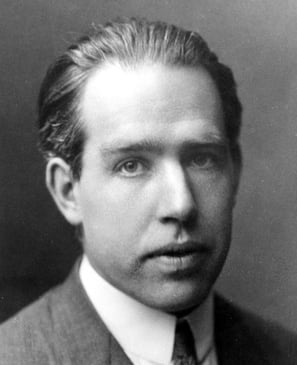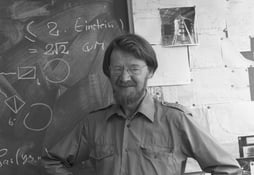
Exploring the Beauty Quantum Entanglement
Quantum entanglement is a phenomenon in quantum physics where two or more particles become linked, such that the state of one particle instantly influences the state of the other, regardless of the distance between them. When particles are entangled, their properties are correlated in a way that measuring one particle will immediately determine the state of its partner, even if separated by vast distances. Although it does not make any sense in classical physics, it has some great implementations in Quantum Physics. In this article we will understand this strange phenomena with some real life examples.
RP
Why is quantum entanglement interesting?
Quantum entanglement is one of the most fascinating and mysterious phenomena in quantum mechanics, often described as the "spooky action at a distance" by Einstein. Its beauty lies in its ability to defy classical understanding, revealing a deeply interconnected quantum universe where particles remain instantaneously linked. When particles are entangled, the measurement of one particle directly influences the state of the other, no matter how far apart they are. This profound phenomenon not only challenges our notions of space and time but also has powerful real-world applications.
Quantum entanglement is the backbone of revolutionary technologies, such as quantum computing, which uses power entanglement to perform complex computations far beyond the capacity of classical computers. It also allows us to design ultra-secure communication due to the quantum mechanical property. Moreover, ongoing research in quantum teleportation and quantum networks suggests that entanglement could shape the future of communication and information processing. The elegance of quantum entanglement lies in both its theoretical beauty and its transformative potential, bridging the gap between the abstract and the practical in modern science. Before we dive deep into the quantum entanglement, let's first understand how all of these started.
When did all of it begin?
The history of quantum entanglement begins in the early 20th century with the development of quantum mechanics. The concept of entanglement was first introduced by Austrian physicist Erwin Schrödinger in 1935, who coined the term "Verschränkung" (entanglement) to describe the strange correlations between particles predicted by quantum theory. However, the idea gained significant attention after the famous Einstein-Podolsky-Rosen (EPR) paper, also published in 1935. Albert Einstein, Boris Podolsky, and Nathan Rosen argued that quantum mechanics must be incomplete. Their concern was that if quantum mechanics were correct, two particles could be instantaneously connected, even when separated by great distances. This idea clashed with the principles of relativity which says, information could not travel faster than light. Their paradox aimed to challenge the foundations of quantum mechanics and suggest the existence of hidden variables that could explain the phenomenon without defying principles of relativity.


Niels Bohr, a leading figure in quantum theory, responded by defending the completeness of quantum mechanics, emphasising that the EPR paradox was not a flaw of quantum physics but a feature of the quantum world’s non-locality. But it seemed impossible to verify that argument at that time. We will discuss what was the ambiguity to design a direct experiment for that.
It wasn't until 1964, when physicist John Bell formulated "Bell’s Theorem," that the debate took a significant turn. For the first, Bell proposed a way to experimentally test whether hidden variables could explain the observed correlations between entangled particles. His theorem demonstrated that it is not possible to reproduce all the predictions of quantum mechanics by local hidden variable theory, meaning that if quantum mechanics were correct, entanglement would involve true non-local interactions as predicted by Niels Bohr
In the 1970s and 1980s, experimentalists like Alain Aspect conducted groundbreaking experiments that confirmed quantum entanglement, showing that Bell’s inequalities were violated. These experiments ruled out hidden variables and confirmed that entangled particles are indeed linked in ways that transcend classical physics.
Deep dive into the quantum entanglement...
Imagine you have two identical coins that are somehow magically entangled. As these coins are entangled, they share a special connection. You put one coin in one box and the other in a second box, and then you send the boxes far apart, say to opposite ends of the Earth. Now, if you open one box and flip the coin, it will randomly show heads or tails. But because the coins are entangled, the moment you check the result of the coin in your box, the coin in the other box instantly takes the opposite result—no matter how far away the other box is. If you get heads, the other box immediately reveals tails, and vice versa, even though there’s no physical interaction or communication between the two. It seems like that observed coin sends a message to the other coin that I have ended up head, so you reveal tails, or vice versa. As this process is instantaneous hence the message transfers immediately, no matter how far they are. This idea directly contradicts the Einstein special theory of relativity which, says that information travels with a finite speed.
In this analogy, the coins represent quantum particles (like electrons or photons), and the heads or tails represent certain measurable properties of the particles, such as spin. The key point is that the outcome of one coin flip immediately determines the result of the other, just like entangled particles.
What was Einstein's argument?
We know Einstein was not happy with this idea. He proposed the hidden variable theory in order to explain this phenomenon. Let's understand this with another example. Imagine two boxes, each containing a ball. Now, somehow we create entanglement between these ball and randomly separate them. We don’t know the colour of the ball in each box, but we certainly say that one box contains a red ball, and the other contains a blue ball. Even though you haven’t opened the boxes yet, the colours are already fixed inside. Einstein's argument was like that there was something or the hidden variable which already fixed the colour of balls in boxes.
Now, you and your friend each take one box, and you walk miles apart. When you open your box and find a red ball, you instantly know that your friend’s box contains the blue ball. In this case, there’s no mystery: the colours were predetermined (by the hidden variables) before you opened the boxes. The same argument can be given for the above experiment with coins. There might be some connection( hidden variable) between coins which have fixed the outcome initially. This is a local, deterministic scenario so there’s no need for spooky action or faster-than-light communication because the outcome was pre-set.
What was the initial ambiguity to verify the quantum entanglement?
In quantum mechanics, before measurement, particles exist in a superposition of states, meaning they do not have definite properties until observed. If we measure entangled particles, we only see the outcome after the measurement, which makes it hard to directly verify the entanglement without interpreting the results based on quantum principles.
Hidden variable theories suggest that the properties of the particles (like spin or polarisation) are pre-determined by some unknown "hidden variables" before measurement. However, quantum mechanics asserts that the particles are in a superposition and that the act of measurement determines the outcome. The ambiguity here is whether the correlation observed between entangled particles is due to true quantum superposition or pre-determined states, as in hidden variable theories.
Let's understand this with an example. Imagine you have two dice that are "entangled," but in a classical hidden variable way. You and your friend take one die each, and you separate into different rooms. According to the hidden variable theory, the dice are pre-programmed with a set of instructions before you measure them.
Now, let’s imagine the dice are quantum dice and truly entangled. According to quantum mechanical interpretation, before you roll the dice, their values are not predetermined. Instead, they are in a state of superposition, meaning both dice are simultaneously showing all possible outcomes ('1, 2, 3, 4, 5, 6') at the same time. Once you measure your die, quantum mechanics says that the result is random, meaning it could be any fixed number. and the outcome of your friend will also be fixed, according to the specific rules of entanglement.
In the quantum mechanical case, you have a fixed outcome and your friend also has a fixed outcome, constrained by the rules of entanglement. Now the ambiguity here is that it is not possible to say that the outcome is quantum mechanical or the hidden variable has fixed the outcome.
A satisfied conclusion...
All of these controversies begin to end when John Bell first proposes a theorem to vary the quantum entanglement. Bell’s theorem showed that if local hidden variables were responsible for quantum measurement outcomes, then certain types of experiments (involving entangled particles) would produce results that respect Bell’s inequalities. However, if quantum mechanics is correct, these experiments would violate Bell’s inequalities, showing stronger correlations than local hidden variables could explain.
Experimental tests of Bell’s inequalities, such as those conducted by Alain Aspect in the 1980s and later by other researchers, consistently violated Bell’s inequalities, supporting the predictions of quantum mechanics.


John Bell at CERN, June 1982
Bohr in 1922
Innovate
Exploring the wonders of quantum technology together.
CONTACT US
Illuminate
© 2024. All rights reserved.
